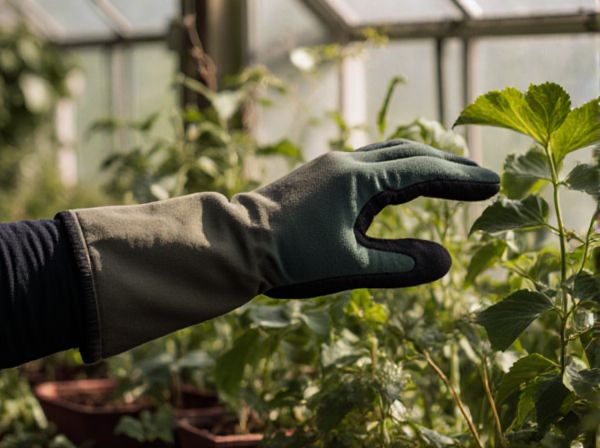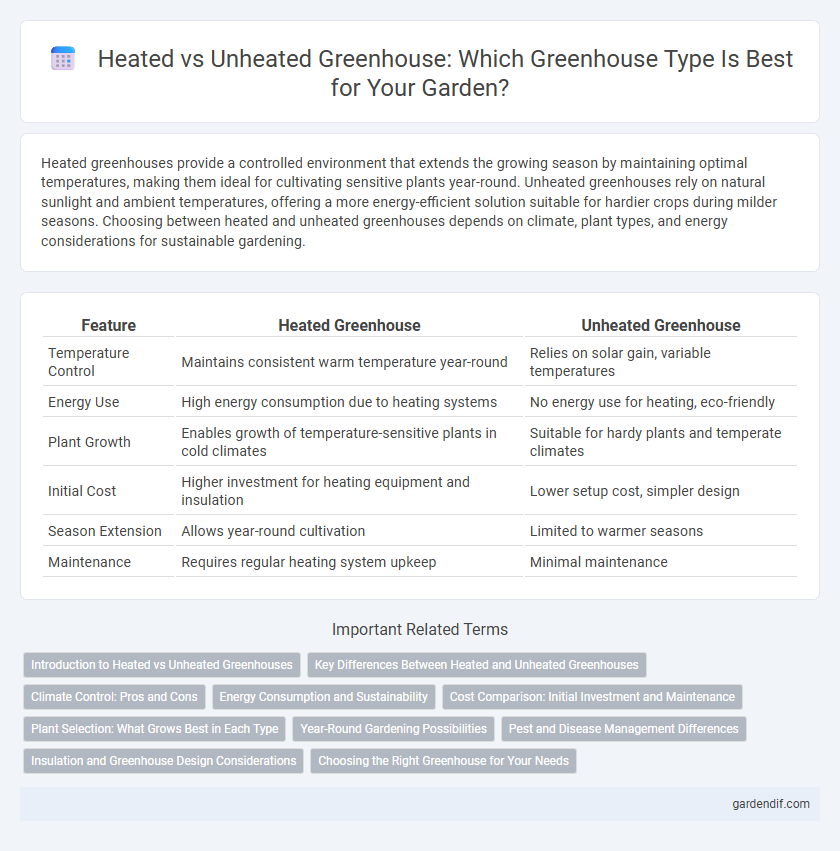
Heated Greenhouse vs Unheated Greenhouse Illustration
Heated greenhouses provide a controlled environment that extends the growing season by maintaining optimal temperatures, making them ideal for cultivating sensitive plants year-round. Unheated greenhouses rely on natural sunlight and ambient temperatures, offering a more energy-efficient solution suitable for hardier crops during milder seasons. Choosing between heated and unheated greenhouses depends on climate, plant types, and energy considerations for sustainable gardening.
Table of Comparison
| Feature | Heated Greenhouse | Unheated Greenhouse |
|---|---|---|
| Temperature Control | Maintains consistent warm temperature year-round | Relies on solar gain, variable temperatures |
| Energy Use | High energy consumption due to heating systems | No energy use for heating, eco-friendly |
| Plant Growth | Enables growth of temperature-sensitive plants in cold climates | Suitable for hardy plants and temperate climates |
| Initial Cost | Higher investment for heating equipment and insulation | Lower setup cost, simpler design |
| Season Extension | Allows year-round cultivation | Limited to warmer seasons |
| Maintenance | Requires regular heating system upkeep | Minimal maintenance |
Introduction to Heated vs Unheated Greenhouses
Heated greenhouses maintain a controlled temperature environment using heating systems, enabling year-round plant growth and protection from frost. Unheated greenhouses rely on solar energy and natural insulation, making them more energy-efficient but limited to seasonal use. Choosing between heated and unheated greenhouses depends on climate, crop requirements, and operational costs.
Key Differences Between Heated and Unheated Greenhouses
Heated greenhouses maintain controlled temperatures using heating systems, enabling year-round growth of temperature-sensitive plants and protection from frost. Unheated greenhouses rely solely on solar energy and insulation, which limits their use to milder seasons and less temperature-sensitive crops. Key differences include energy consumption, temperature regulation, plant variety suitability, and operational costs.
Climate Control: Pros and Cons
Heated greenhouses maintain optimal temperature year-round, enabling extended growing seasons and protection against frost, but require higher energy consumption and operational costs. Unheated greenhouses rely on natural sunlight and ambient temperature, offering lower expenses and sustainable operation but are limited by colder climates and shorter growing periods. Both types demand careful climate control management to balance plant health, energy efficiency, and cost-effectiveness.
Energy Consumption and Sustainability
Heated greenhouses require significant energy inputs, primarily from fossil fuels or electricity, to maintain optimal growing temperatures, leading to higher operational costs and increased carbon emissions. Unheated greenhouses rely on passive solar heating and natural insulation, drastically reducing energy consumption and supporting sustainable, low-impact cultivation. Incorporating renewable energy systems and thermal mass in heated greenhouses can enhance sustainability by minimizing fossil fuel dependence.
Cost Comparison: Initial Investment and Maintenance
Heated greenhouses require a significantly higher initial investment due to the installation of heating systems, insulation, and energy infrastructure, while unheated greenhouses have lower upfront costs with simpler structural requirements. Maintenance expenses for heated greenhouses include ongoing fuel or energy costs and regular heating system upkeep, increasing operational costs compared to unheated greenhouses, which typically incur minimal maintenance expenditure focused on ventilation and structural repairs. The cost savings of unheated greenhouses can be substantial over time, but heated greenhouses provide extended growing seasons and climate control, influencing the overall cost-benefit analysis.
Plant Selection: What Grows Best in Each Type
Heated greenhouses provide a controlled environment ideal for cultivating tropical and subtropical plants such as orchids, tomatoes, and cucumbers, which require consistent warmth and humidity levels. Unheated greenhouses suit cold-hardy crops like lettuce, spinach, kale, and certain herbs that can thrive in cooler temperatures while still benefiting from frost protection. Selecting plants based on temperature tolerance ensures optimal growth, extended growing seasons, and higher yields in both heated and unheated greenhouse settings.
Year-Round Gardening Possibilities
Heated greenhouses enable year-round gardening by maintaining optimal temperatures that support plant growth during cold months, extending growing seasons regardless of external climate. Unheated greenhouses rely on solar energy and ambient warmth, which limits gardening to milder seasons and early frost periods. Consistent temperature control in heated greenhouses promotes diverse crop cultivation and increases yield reliability throughout the year.
Pest and Disease Management Differences
Heated greenhouses maintain controlled temperatures that reduce humidity fluctuations, creating less favorable conditions for pests and diseases like powdery mildew and botrytis, which thrive in variable climates. Unheated greenhouses often experience greater temperature swings and higher humidity, increasing the risk of pest infestations and fungal diseases due to inconsistent environmental conditions. Effective pest and disease management in heated greenhouses relies on stable climate control, while unheated structures require more frequent monitoring and preventive measures to mitigate outbreaks.
Insulation and Greenhouse Design Considerations
Heated greenhouses incorporate advanced insulation materials such as double glazing and thermal screens to retain heat efficiently, enabling year-round cultivation and protection against frost. Unheated greenhouses rely on passive solar design elements like south-facing orientation and thermal mass to maximize natural warmth but require meticulous design to minimize heat loss during colder months. Proper greenhouse design must balance insulation performance with ventilation needs to optimize plant growth environments in both heated and unheated structures.
Choosing the Right Greenhouse for Your Needs
Heated greenhouses provide controlled temperature environments, extending the growing season and enabling year-round cultivation of temperature-sensitive plants. Unheated greenhouses rely on natural sunlight and ambient temperatures, making them more energy-efficient but less effective in colder climates or off-season growth. Evaluating factors like local climate, crop type, and budget is essential when choosing between heated and unheated greenhouses to optimize plant health and yield.
Heated Greenhouse vs Unheated Greenhouse Infographic

 gardendif.com
gardendif.com